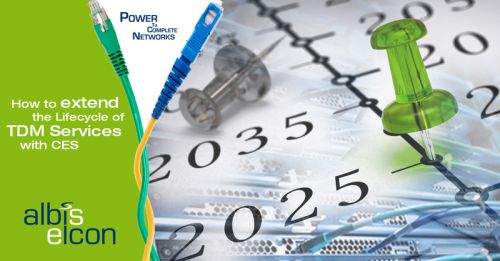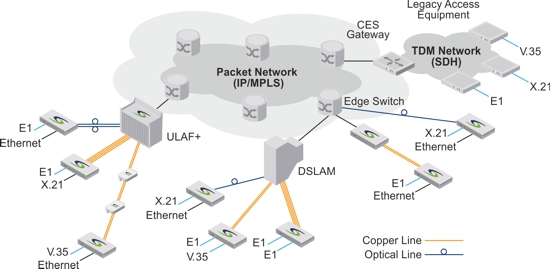
Many TDM based leased line services have been rolled out and are still up and running today. Despite the shift from TDM to a more efficient packet network, the nx64kbps TDM services based on E1, X.21 and V.35 interfaces are still widely deployed for business services and can make a substantial contribution to the network operator’s revenue. The applications that are realized based on these TDM services are mobile backhauling, voice interconnections and data connections to any router and legacy equipment including ATM and frame relay. This paper addresses the challenges many carriers and network operators are facing today and in the near future with regards to the lifecycle of their currently offered TDM services. It shows a way how to extend the lifecycle of TDM services with CES – Circuit Emulation Service.
Motivation
The fact that TDM networks are replaced by more efficient packet networks, together with the situation that legacy equipment reaches end of its life cycle, puts operators in a dilemma.
On one side, carriers need to move forward and replace the legacy TDM network with new technology. On the other side, their customers are not ready to replace TDM based services by a packet based services and are therefore willing to pay good prices for these legacy services.
The solution to this dilemma can be CES – Circuit Emulation Service for TDM services!
CES combinesthe legacy TDM world with the efficiency of the packet networks transport, while preserving the same quality of experience to the end users.
In addition to the TDM services which can continuously be offered with CES, Carrier Ethernet based services can be introduced in parallel and provide a smooth migration path for future service offerings.
CES – How does it work?
The CES functionality is realized in the CES interworking function (IWF).
The TDM payload is encapsulated into packets and header information is added to transport the packets to the destination, identify the individual emulated circuit and signal alarming information to the peering IWF. This emulated circuit is also referred to as pseudo wire.
On the receiving IWF, the packets are stored into a jitter buffer to compensate packet delay variation (jitter) and allow packet reordering if needed. The CES IWF then generates the TDM signal out of the received TDM payload and delivers it to the client. The same principle is applied in the opposite direction of the traffic flow.
The IWF’s require a clock to regenerate a failure free TDM signal out of the CES packets.
The clock can be distributed to the IWF on the physical layer via NTR (Network Timing Reference) which is an accurate standardized method for frequency distribution in DSL access network such as SHDSL. SyncE (Synchronous Ethernet) uses a clock distribution mechanism similar to that known from SDH with comparable quality. SyncE is a link-by-link frequency distribution scheme and therefore requires the entire clock distribution path to be SyncE compliant. And finally, PTP (Precision Timing Protocol – IEEE 1588v2) provides a protocol based distribution of frequency phase and time of day information between the end points to recover the clock out of the packet stream. With these clock distribution options various network scenarios can be addressed.
Packet networks have many advantages compared to the traditional TDM based transport networks to help operators bring down their costs. In order to guarantee the same quality of experience for the services produced on a packet network compared to the SDH network, Quality of Service (QoS) measures must be taken within the packet network. The CES demarcation device therefore shall support the Carrier Ethernet attributes as defined by MEF (Metro Ethernet Forum). These allow classification of the services and assign them the appropriate priority to guarantee the SLA. Additionally, the CES device shall provide all required performance information and statistics to prove the service level agreement (SLA) to the end customer.
CES payload formats and encapsulation options are standardized by the following organizations with the respective standards or recommendations:
- Broadband Forum: MFA 8.0.0
- IETF: RFC 4553, RFC 5086
- ITU-T: Y.1413
- Metro Ethernet Forum: MEF 8
Implementation scenarios for CES
Current TDM services are often realized with legacy access solutions and SDH networks are utilized to transport the service. G.703 (E1) interfaces and X.21, V.35/36 data interfaces are provided to the customers. This has been in operation for many years but now, this technology has reached the end of its lifecycle which forces the carriers to get active.
The legacy networks will be replaced by packet based networks over time. In the meantime, both networks will coexist and therefore CES gateways must provide interworking between the two networks. This step allows the migration of TDM services from the legacy network to the packet network – without any change of the service provided to the end customer.
Dedicated legacy access equipment can be dismantled and the services are moved to a DSLAM or MSAN platform, providing the connectivity over copper or fibre to the customer site. The CPE at the customer site provides the CES IWF and the required interface to deliver the TDM service.
Existing aggregation platforms at the network edge can provide optical connectivity or specific transmission requirements that can not be provided or does not make business sense to be realized via the DSLAM.
After the customer has been migrated to the new packet based platform, additional Carrier Ethernet based services can be offered to the customer in parallel to the TDM service delivered via CES. This can open new business opportunities which where not possible before or required different CPE to terminate the services at the customer.
At some point, when all legacy access and TDM equipment has been dismantled, the CES gateways are not required anymore. During this time frame, probably also the customers will be willing or forced to make a change and move away from the TDM service to packet based services. The CPE therefore not only must provide the CES IWF but also must be a carrier Ethernet demarcation device. This way, a smooth migration of services can be realized with minimal impact to the end customer and low migration costs to the carrier.
Summary and Conclusion
TDM services will still be offered and need to be operated by carriers for the next years to come.
The fact that the TDM equipment introduced to produce these services reaches the end of the lifecycle and causes increasing operational costs forces the carriers to take action.
They need to modernize their network while still providing the legacy TDM services.
Circuit Emulation Service – CES is the answer to this challenge. CES solutions utilize the efficient transport of the packet networks while still providing the TDM interfaces. In addition to the TDM services, new packet based services can be introduced to provide an additional revenue stream to the carrier. The Ethernet interfaces provide a smooth migration path for a pure packet based end to end service offering in the future.
![]() The ULAF+ ACCEED product family is a group of devices with various interface combinations and access media support to cover various network scenario requirements.
The ULAF+ ACCEED product family is a group of devices with various interface combinations and access media support to cover various network scenario requirements.
Combining the flexible CES functionality with the powerful Carrier Ethernet features makes ACCEED to a compelling solution to your network migration story.
Take action now with “ACCEED” – albis-elcon supports you on your way.






